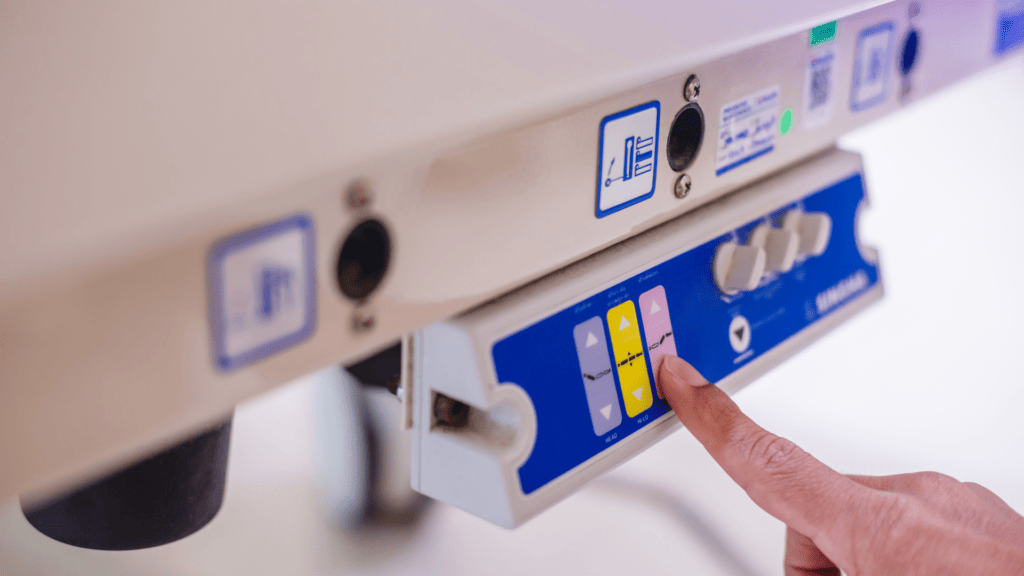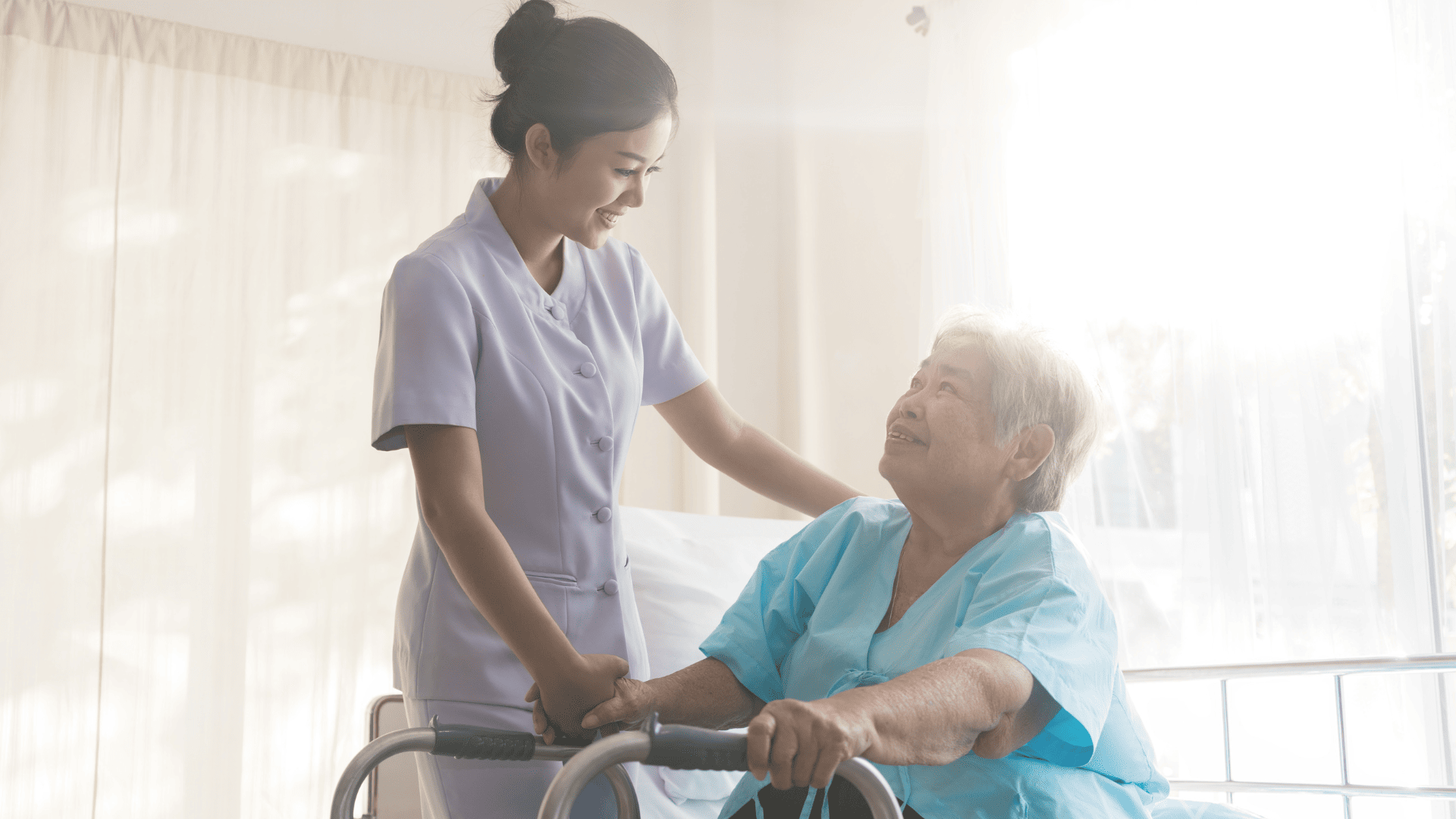Stroke survivors may face mental and physical difficulties during the rehabilitation process. Rehabilitation and recovery from a stroke can be greatly aided by the provision of adequate care and support. Patient satisfaction, safety, and healing are all influenced by the quality of hospital beds. The features and benefits of hospital beds designed specifically for people recovering from a stroke are discussed below. Learn how the use of hospital beds can improve the lives and abilities of stroke patients by facilitating their return to self-care.
Stroke: Its Origins and Consequences
If a part of the brain suddenly loses its supply of blood and oxygen, this is called a stroke. As the cells die off, the person loses the ability to use the parts of the brain that regulate things like memory and muscular control.
Stroke survivors have cognitive and emotional changes in addition to physical impairments. Physical symptoms such as convulsions, chronic pain, and exhaustion are the most typical aftereffects of a stroke. Additionally, some typical adverse effects include:
- Loss of ability to move voluntarily; paralysis
- The inability to regulate one's own body, leading to issues with walking, balance, and posture.
- Unilateral or localised weakness (e.g., in just one cheek, arm, or leg)
- Difficulty swallowing
- Affected sensitivity to pain, temperature, location, or touch
- Lack of awareness of what one is holding
Because of the unique challenges each stroke survivor has, the length of time it takes them to get better varies widely. Some patients will need long-term care and rehabilitation after experiencing difficulties with movement, cognition, and speech immediately following a stroke. A hospital bed can be an indispensable piece of medical equipment for any duration of stay.
Benefits of Medical Electric Beds for Post-Stroke Patients
Medical electric beds offer numerous benefits for post-stroke patients, aiding in their recovery and overall well-being. Here are some of the key advantages:
- Adjustable Positions for Comfort and Safety: Medical electric beds can be easily adjusted to different positions, allowing patients to find a comfortable posture. They can elevate the head and back, flex the legs and knees, and even use Trendelenburg and Reverse Trendelenburg positions. These adjustments help reduce pressure on certain body parts, enhance circulation, and prevent discomfort.
- Pressure Relief and Prevention of Bedsores: Post-stroke patients are often at risk of developing pressure ulcers due to limited mobility. Electric beds with pressure redistribution mattresses help alleviate pressure points, minimizing the risk of bedsores and promoting faster healing.
- Enhanced Circulation and Fluid Drainage: Electric beds can be positioned to elevate the legs, promoting better blood circulation and reducing swelling. This can be especially beneficial for patients who experience edema or have compromised circulation due to immobility.
- Reduced Risk of Falls and Injuries: Post-stroke patients may have difficulties with balance and mobility, making them susceptible to falls. Electric beds with side rails and adjustable heights can prevent falls, providing a safer environment for patients.
- Promoting Restful Sleep and Psychological Well-being: Comfortable positioning and reduced pain contribute to better sleep quality, which is crucial for the healing process. A good night's sleep also positively affects a patient's mood and psychological well-being during the recovery period.
- Facilitating Active and Passive Exercises: Electric beds can be adjusted to support various physical therapy exercises. They enable post-stroke patients to perform active movements and also assist caregivers in administering passive exercises, helping improve muscle strength and joint flexibility.
- Supporting Mobility and Transfer: Many electric beds have features like adjustable height and side rails that aid patients in getting in and out of bed safely. This enhances their independence and reduces the physical strain on caregivers during transfers.
- Aiding in Positioning for Therapies and Procedures: The ability to adjust the bed's position allows healthcare professionals to position patients optimally for treatments, examinations, and medical procedures, improving the efficiency and effectiveness of healthcare delivery.
- Easier Caregiver Assistance with Adjustments and Transfers: Electric beds can be adjusted remotely, which simplifies caregiver tasks and minimizes the risk of injury associated with manual adjustments.
- Integration with Monitoring Devices: Some medical electric beds can integrate with monitoring devices, allowing healthcare providers to track vital signs and other health parameters conveniently.
- Management of Respiratory Issues: Certain electric beds offer features like head elevation, which can help manage respiratory conditions by promoting lung expansion and facilitating breathing.
In the rehabilitation process following a stroke, medical electric beds play an important role by ensuring the patient's comfort, safety, and support. They provide a number of features that are tailored to the specific requirements of stroke patients, leading to better results and an enhanced quality of life.
Impact on Physical Rehabilitation
The use of medical electric beds can have a positive impact on physical rehabilitation for post-stroke patients. These beds provide essential features and functionalities that aid in the recovery process and support the patient's physical rehabilitation efforts. Here are some ways in which medical electric beds impact physical rehabilitation:
Facilitating Active and Passive Exercises
Medical electric beds can be adjusted to various positions, allowing post-stroke patients to perform active exercises more comfortably. Patients can engage in range-of-motion exercises, leg lifts, and other movements that help improve muscle strength and flexibility. Additionally, the beds assist caregivers in administering passive exercises, where they move the patient's limbs gently, promoting better joint mobility.
Supporting Mobility and Transfer
Many medical electric beds are equipped with features such as adjustable heights and side rails, making it easier for post-stroke patients to get in and out of bed safely. This increased mobility helps patients regain independence and practice mobility skills, essential for rehabilitation.
Aiding in Positioning for Therapies and Procedures
Electric beds can be adjusted to provide the optimal position for various therapies and medical procedures. For example, during physical therapy sessions, the bed can be adjusted to facilitate exercises or treatments more effectively. It also allows healthcare professionals to position patients properly for wound care, respiratory treatments, and other therapies, enhancing their effectiveness.
Assistance with Daily Activities
Electric beds can be adjusted to accommodate various daily activities, such as eating, reading, and engaging in leisure activities. This adaptability enables patients to maintain a level of independence and functionality while recovering.
Reduction of Muscle Stiffness and Contractures
Immobility after a stroke can lead to muscle stiffness and contractures. The ability to change bed positions allows patients to stretch and move their limbs regularly, preventing these complications and promoting better circulation.
Pain Management and Comfort
Medical electric beds can be adjusted to minimize pressure on specific areas of the body, reducing pain and discomfort. Enhanced comfort levels make patients more receptive to rehabilitation exercises and therapy sessions.
Promotion of Rest and Healing
Electric beds can be positioned to provide a comfortable sleeping posture, facilitating better rest and recovery during the night. Quality sleep is crucial for the body's healing processes, and a well-rested patient is more likely to engage actively in rehabilitation efforts during the day.
Reducing Caregiver Strain
The adjustable features of electric beds make caregiving tasks more manageable, reducing strain and injuries for caregivers during transfers and positioning. This ensures that caregivers can focus more on providing effective support to patients throughout the rehabilitation journey.
Functions for Medical Care and Monitoring
Many modern medical electric beds have built-in monitoring and medical care capabilities that improve the quality of care, patient safety, and doctor-patient communication. These technological additions make receiving healthcare easier and more convenient. Here is a rundown of the diagnostic and therapeutic capabilities of medical electric beds:
- Integration with Monitoring Devices: Some medical electric beds are designed to integrate with monitoring devices such as vital signs monitors, pulse oximeters, and cardiac telemetry systems. This integration allows healthcare providers to continuously track important health parameters of the patient, such as heart rate, blood pressure, respiratory rate, and oxygen saturation. Real-time monitoring enables early detection of any concerning changes in the patient's condition, facilitating prompt medical interventions if needed.
- Access to Medical Care from the Bed: Certain medical electric beds come with built-in communication systems that allow patients to directly connect with healthcare professionals and caregivers without having to leave the bed. These communication systems may include nurse call buttons or intercoms, enabling patients to request assistance or communicate their needs easily.
- Remote Monitoring and Telemedicine Applications: Advances in telemedicine have been integrated into some medical electric beds, enabling remote monitoring and virtual consultations. Healthcare providers can remotely assess a patient's condition, review vital signs data, and conduct video consultations. This feature is particularly beneficial for patients who require ongoing monitoring and care but may not be able to visit a healthcare facility frequently.
- Alert and Safety Systems: Medical electric beds may be equipped with alert systems to ensure patient safety. For example, bed exit alarms can notify caregivers if a patient attempts to get out of bed unsafely, reducing the risk of falls. Additionally, some beds have weight sensors that can trigger alerts if the patient's weight distribution indicates an increased risk of pressure ulcers.
- Medication Management: Some advanced medical electric beds may have medication management features. These beds can remind patients to take their medications at scheduled times, ensuring adherence to prescribed treatments.
- Data Recording and Documentation: Many medical electric beds have electronic data recording capabilities, allowing healthcare providers to track and document patient care activities, therapy sessions, and bed adjustments. This electronic documentation streamlines the patient's medical record-keeping process and ensures accurate and up-to-date information.
- Smart Bed Technology: In some cases, medical electric beds are equipped with smart technology that can analyze data and identify patterns or trends in a patient's health. This data-driven approach can assist healthcare providers in making informed decisions regarding the patient's care and treatment plan.
- Wound Care and Prevention Features: Some medical electric beds have specialized surfaces for wound care management. These surfaces can alternate pressure points to promote blood flow and prevent pressure ulcers in bedridden patients.
With real-time data monitoring, improved communication, and safety safeguards, medical electric beds have revolutionised patient care. Better patient outcomes and an enhanced healthcare experience are the results of these features' aiding healthcare providers in providing timely and individualised care.
Conclusion
Medical electric beds are crucial for post-stroke recovery, as they offer numerous benefits for patients' comfort, safety, and overall well-being. These beds can be adjusted to different positions, allowing patients to find a comfortable posture and reduce pressure on certain body parts. They also help in pressure relief and prevention of bedsores, enhancing circulation and fluid drainage, reducing the risk of falls and injuries, and promoting restful sleep and psychological well-being.
Electric beds can also support active and passive exercises, enabling patients to perform active movements and assist caregivers in administering passive exercises, improving muscle strength and joint flexibility. They also facilitate mobility and transfer, allowing patients to get in and out of bed safely, enhancing independence and reducing physical strain on caregivers during transfers.
Electric beds can also assist with daily activities, reducing muscle stiffness and contractures, pain management and comfort, and promoting rest and healing. They also reduce caregiver strain, making caregiving tasks more manageable.
Functions for medical care and monitoring are built-in in modern medical electric beds, improving the quality of care, patient safety, and doctor-patient communication. These technological additions make receiving healthcare easier and more convenient.
Content Summary
- Stroke survivors may face mental and physical difficulties during the rehabilitation process.
- Rehabilitation and recovery from a stroke can be greatly aided by the provision of adequate care and support.
- Patient satisfaction, safety, and healing are all influenced by the quality of hospital beds.
- The features and benefits of hospital beds designed specifically for people recovering from a stroke are discussed below.
- Learn how the use of hospital beds can improve the lives and abilities of stroke patients by facilitating their return to self-care.
- Some patients will need long-term care and rehabilitation after experiencing difficulties with movement, cognition, and speech immediately following a stroke.
- A hospital bed can be an indispensable piece of medical equipment for any duration of stay.
- Electric beds can be positioned to elevate the legs, promoting better blood circulation and reducing swelling.
- Post-stroke patients may have difficulties with balance and mobility, making them susceptible to falls.
- Electric beds with side rails and adjustable heights can prevent falls, providing a safer environment for patients.
- Comfortable positioning and reduced pain contribute to better sleep quality, which is crucial for the healing process.
- Electric beds can be adjusted to support various physical therapy exercises.
- Many electric beds have features like adjustable height and side rails that aid patients in getting in and out of bed safely.
- In the rehabilitation process following a stroke, medical electric beds play an important role by ensuring the patient's comfort, safety, and support.
- They provide a number of features that are tailored to the specific requirements of stroke patients, leading to better results and an enhanced quality of life.
- The use of medical electric beds can have a positive impact on physical rehabilitation for post-stroke patients.
- Medical electric beds can be adjusted to various positions, allowing post-stroke patients to perform active exercises more comfortably.
- Patients can engage in range-of-motion exercises, leg lifts, and other movements that help improve muscle strength and flexibility.
- Additionally, the beds assist caregivers in administering passive exercises, where they move the patient's limbs gently, promoting better joint mobility.
- Many medical electric beds are equipped with features such as adjustable heights and side rails, making it easier for post-stroke patients to get in and out of bed safely.
- This increased mobility helps patients regain independence and practice mobility skills, essential for rehabilitation.
- Electric beds can be adjusted to provide the optimal position for various therapies and medical procedures.
- For example, during physical therapy sessions, the bed can be adjusted to facilitate exercises or treatments more effectively.
- It also allows healthcare professionals to position patients properly for wound care, respiratory treatments, and other therapies, enhancing their effectiveness.
- Medical electric beds can be adjusted to minimize pressure on specific areas of the body, reducing pain and discomfort.
- Enhanced comfort levels make patients more receptive to rehabilitation exercises and therapy sessions.
- Electric beds can be positioned to provide a comfortable sleeping posture, facilitating better rest and recovery during the night.
- The adjustable features of electric beds make caregiving tasks more manageable, reducing strain and injuries for caregivers during transfers and positioning.
- Many modern medical electric beds have built-in monitoring and medical care capabilities that improve the quality of care, patient safety, and doctor-patient communication.
- These technological additions make receiving healthcare easier and more convenient.
- Some medical electric beds are designed to integrate with monitoring devices such as vital signs monitors, pulse oximeters, and cardiac telemetry systems.
- Certain medical electric beds come with built-in communication systems that allow patients to directly connect with healthcare professionals and caregivers without having to leave the bed.
- Advances in telemedicine have been integrated into some medical electric beds, enabling remote monitoring and virtual consultations.
- This feature is particularly beneficial for patients who require ongoing monitoring and care but may not be able to visit a healthcare facility frequently.
- Medical electric beds may be equipped with alert systems to ensure patient safety.
- Some advanced medical electric beds may have medication management features.
- Many medical electric beds have electronic data recording capabilities, allowing healthcare providers to track and document patient care activities, therapy sessions, and bed adjustments.
- This electronic documentation streamlines the patient's medical record-keeping process and ensures accurate and up-to-date information.
- In some cases, medical electric beds are equipped with smart technology that can analyze data and identify patterns or trends in a patient's health.
- This data-driven approach can assist healthcare providers in making informed decisions regarding the patient's care and treatment plan.
- Some medical electric beds have specialized surfaces for wound care management.
- With real-time data monitoring, improved communication, and safety safeguards, medical electric beds have revolutionised patient care.
- Better patient outcomes and an enhanced healthcare experience are the results of these features' aiding healthcare providers in providing timely and individualised care.
FAQs About Medical Beds
Yes, there are homecare medical beds designed for home use. These beds offer similar features to hospital beds but are more compact and aesthetically suitable for home environments.
Medical beds support and place patients in hospitals. Medical beds contain head and foot elevation, allowing patients to select comfortable positions for their medical needs. These beds have extra accessories and safety measures, making them suited for hospitals, long-term care centres, and homecare.
Adjustable medical beds have electric motors that power the adjustable components. Users or caregivers can control the bed's position using a remote or buttons on the side rails.
Medical beds offer various benefits, including improved sleep quality, enhanced circulation, pain relief, and support for medical conditions. They are particularly helpful in post-surgery recovery and aiding patients with limited mobility.
The coverage of medical beds varies depending on the patient's medical condition and insurance policy. Some medical beds may be partially or fully covered if deemed medically necessary. It's essential to check with the insurance provider for specific coverage details.


